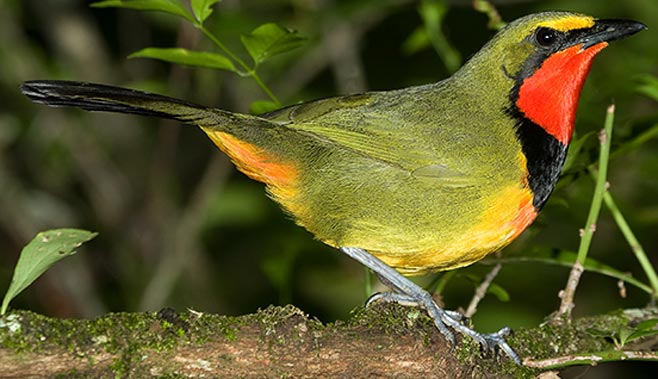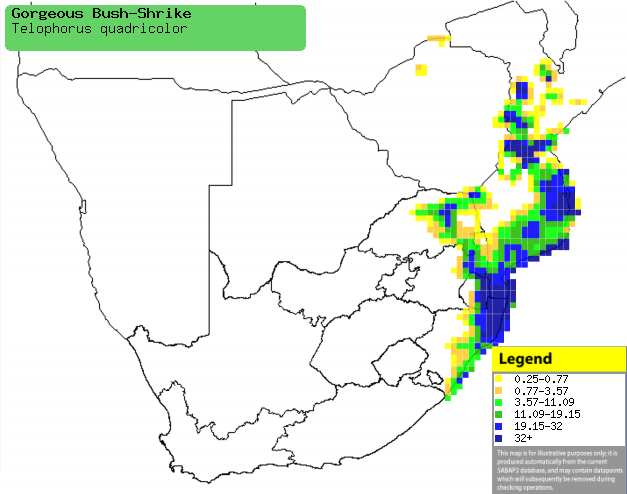|
Telophorus viridis (Gorgeous
bush-shrike)
Konkoit [Afrikaans]; iNgongoni [Zulu]; Bonte bosklauwier
[Dutch]; Gladiateur quadricolore [French]; Vierfarbenwürger [German];
Picanço-quadricolor [Portuguese]
Life
> Eukaryotes >
Opisthokonta
> Metazoa (animals) >
Bilateria >
Deuterostomia > Chordata >
Craniata > Vertebrata (vertebrates) > Gnathostomata (jawed
vertebrates) > Teleostomi (teleost fish) > Osteichthyes (bony fish) > Class:
Sarcopterygii (lobe-finned
fish) > Stegocephalia (terrestrial
vertebrates) > Tetrapoda
(four-legged vertebrates) > Reptiliomorpha > Amniota >
Reptilia (reptiles) >
Romeriida > Diapsida > Archosauromorpha > Archosauria >
Dinosauria
(dinosaurs) > Saurischia > Theropoda (bipedal predatory dinosaurs) >
Coelurosauria > Maniraptora > Aves
(birds) >
Order: Passeriformes
> Family: Malaconotidae
 |
|
Gorgeous bush-shrike, Nkwaleni Valley, just
north of Eshowe in KwaZulu-Natal, South Africa.. [photo
Hugh Chittenden ©] |
Distribution and habitat
Occurs in two separate populations - one along the coast of
Tanzania and Kenya and the other in Mozambique, Zimbabwe's eastern Highlands,
Limpopo Province, Mpumalanga and KwaZulu-Natal. Although fairly common it is
quite difficult to see, as it skulks around in dense undergrowth, giving away
its away it presence with its distinctive call. It usually occupies woodlands
with dense undergrowth, especially riparian woodland. It also occurs in wooded
drainage lines in thornveld, forest fringes, dune forest and coastal evergreen
forest patches.
|
 |
|
Distribution of Gorgeous bush-shrike in southern Africa,
based on statistical smoothing of the records from first SA Bird Atlas
Project (©
Animal Demography unit, University of
Cape Town; smoothing by Birgit Erni and Francesca Little). Colours range
from dark blue (most common) through to yellow (least common).
See here for the latest distribution
from the SABAP2. |
Predators and parasites
Nestlings have been recorded as prey of
Accipiter badius (Shikra).
Food
It mainly eats insects, doing most of its foraging in the
canopy of trees, gleaning insects from leaves and branches. The following food
items have been recorded in its diet:
Breeding
- Both sexes construct the nest, which is an untidy, shallow cup built of
fine twigs, rootlets, leaf petioles and grass, sometimes secured with spider
web. It is usually placed on a horizontal branch or fork of a thorny tree,
but also in tangles of creepers.
- Egg-laying season peaks from October-December.
- It lays 1-3 eggs, which are incubated by both sexes for about 13-14
days.
- In one observation the chicks were cared for by both parents, leaving
the nest after 12 days.
Threats
Not threatened, in fact widespread across sub-Saharan
Africa. s
References
-
Hockey PAR, Dean WRJ and Ryan PG 2005. Roberts
- Birds of southern Africa, VIIth ed. The Trustees of the John Voelcker
Bird Book Fund, Cape Town.
Distribution and habitat
Occurs in many areas of Sub-Saharan Africa, excluding much
of the western Coast and the DRC. In southern Africa it is fairly common across
Zimbabwe, Mozambique, parts of Botswana and the Caprivi Strip, extending into
Swaziland, the Kruger National Park, Mpumalanga, KwaZulu-Natal and the Eastern
Cape. It generally prefers riparian woodland, as well as wooded drainage lines
in savanna, miombo (Brachystegia) woodland, avoiding evergreen forest.
Food
It mainly eats insects, doing most of its foraging in the
canopy of trees, gleaning insects from leaves and branches. The following food
items have been recorded in its diet:
- Insects
- beetles
- caterpillars
- mantids
- wasps
- bees
Breeding
- Both sexes construct the nest, which is an untidy, shallow cup built of
fine twigs, rootlets, leaf petioles and grass, sometimes secured with spider
web. It is usually placed on a horizontal branch or fork of a thorny tree,
but also in tangles of creepers.
- Egg-laying season peaks from October-December.
- It lays 1-3 eggs, which are incubated by both sexes for about 13-14
days.
- In one observation the chicks were cared for by both parents, leaving
the nest after 12 days.
Threats
Not threatened, in fact widespread across sub-Saharan
Africa. s
References
-
Hockey PAR, Dean WRJ and Ryan PG 2005. Roberts
- Birds of southern Africa, VIIth ed. The Trustees of the John Voelcker
Bird Book Fund, Cape Town.
|
